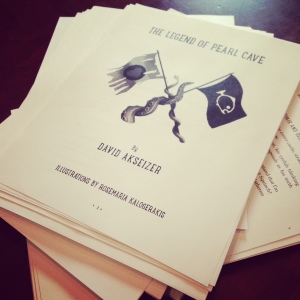By David Akseizer
I’m happy to announce that The Legend of Pearl Cave has entered the proofreading stage of the publishing process. Cheers. Applause. More cheers. Cricket…Cricket. What? Not impressed? I get it legend fans. You want your copy and you want it now. Don’t worry! Hang in there. We’re only a few weeks away from sending The Legend of Pearl Cave to the printers. At this rate, you’ll be able to purchase a copy of my book in no time at all. This I promise.
For those of you who are not familiar with the publishing process, the proofreading stage occurs after the author and editor have exhausted all their efforts to make a book the best darn book it can be. Qualified experts, aside from the author and editor, read through your work with a fine-toothed comb. These proofreading detectives for hire whip out their oversized magnifying glass in search of annoying grammatical errors and distracting inconsistencies within a book. Boy am I glad the proofreading stage exists. I know I’m the first to complain or become distracted when I’m reading a book and find a mistace (joking). Let’s hope my team of proofreaders have magnifying glasses as big as the sun.
Last time we discussed the importance of developing an outline that will help steer your writing in the proper direction, define the direction your headed in, and direct you on how to get there.
Summary (examples of outlines were provided in my previous blog post):
- Outlines will help keep you focused as you begin to develop your characters and plot.
- Outlines enhance your overall thought process and help to write the chapters more effortlessly.
- Outlines keep you from getting lost or straying away from your original ideas.
- Outlines will allow you to meet all your deadlines.
Lesson 3: The Hook
From the minute I first began writing The Legend of Pearl Cave, I realized the importance of the hook. By “hook” I’m referring to your opening line as well as the opening paragraph to a story. The first few sentences of a story are the most crucial. This concept can best be compared to a blind date. Your initial impression is everything. The goal is to find a way to make a lasting impression within the first few minutes of meeting someone that convinces them to stick around for the entire date. The same concept applies when writing the hook. Write a hook that will convince your reader to stick around and finish reading your book. It’s that simple.
First sentence guidelines (compliments of my high school english teacher):
- Establish tone.
- Hint at a conflict or your overall theme.
- Lure readers in with the promise of some reward (reward meaning: the emotional reward of reading the book).
- Cause an instant emotional reaction, connection to a character, and or fascination with the scene.
And remember fans, you wouldn’t attend a fireworks show without any fireworks. The beginning of your book should be explosive. Write opening sentences that suck your reader in like a gigantic black vortex swallowing planet earth. Make sure they can’t resist the pull and are forced to read on. Don’t rush this process. Take your time! Tryout a few different ideas before settling on a final hook.
Tune in next time when I will discuss the beginning, the middle, and the end. This applies to chapters and the book as a whole.
If you have any questions, please visit www.davidakseizer.com and shoot me an email. You can also follow me on twitter at https://twitter.com/akseizer and send me a message. Until then!

